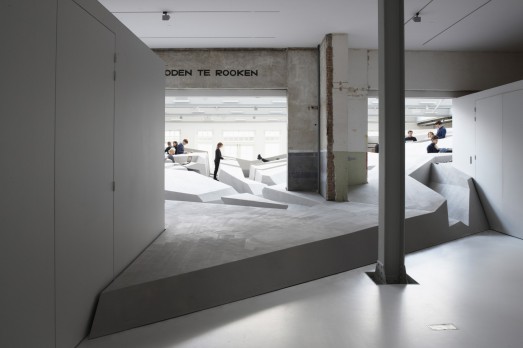CityLab
INSPIRATION
Nora Sturges
This group of paintings of imaginary cities -- inspired in part by my living in Baltimore -- explores the theme of human inhabitation of the environment and the process of urban growth and decline.
Paul Flannery
My drawings illustrate ways in which individual bodies connect together and interact to create a communal whole. As such they act as a kind of exploration into social networks of – more often than not – human connectedness. Housed in an anamorphous architecture not unlike the Architecture Parlante of Claude-Nicolas Ledoux in which the shape, size and situation of the structure describes its function in the community, characters viewed voyeuristically through windows create a communal narrative. Like comic book cells, the space of each inhabitant links together with those around it and individual sub-cultures become part of something bigger. A lot of my work is concerned with the disrupted narrative associations of the comic book and a lot of the architecture – and I use the word loosely – I use is a way of knitting together individual frames of a larger narrative.
The City Sheds Scales of its Past, 2008, oil on MDF, 11x10.5 inches
City with Roof Decks,
2007, oil on MDF, 9x7 inches
Cliff Town, 2007,
oil on MDF, 6.5x7 inches
Ballade of the Lostest – No Government,
2007, pencil on paper, 105 x 152 cm
Note to Self
2006, pencil on paper, 29.5 x 21 cm
P
A
R
T
I
P
A
R
T
I
untitled - room 3
RAAAF
The End of Sitting
The End of Sitting is een ruimtelijke installatie op het snijvlak van beeldende kunst, architectuur, filosofie en empirische wetenschap. In onze maatschappij is bijna de gehele omgeving ontworpen voor het zitten, terwijl medisch onderzoek heeft aangetoond dat te veel zitten ongezond is. RAAAF [Rietveld Architecture-Art-Affordances] en beeldend kunstenaar Barbara Visser hebben een fysiek denkbeeld voor de toekomstige werkplek ontwikkeld waarin de stoel en tafel niet langer het uitgangspunt zijn. De affordances (handelingsmogelijkheden) van het experimentele werklandschap dagen mensen uit om wisselende werkposities gedurende een dag aan te nemen. The End of Sitting is een eerste stap richting een toekomst waarin staand werken de nieuwe norm is. Dit project is een ruimtelijke voortzetting van de eerdere animatie ‘Sitting Kills’ van RAAAF | Barbara Visser, ontwikkeld voor het Atelier Rijksbouwmeester.
The End of Sitting is ontstaan in samenwerking met Looiergracht 60 (Soraya Notoadikusumo en Nadine Snijders), een nieuwe ruimte voor kunst en wetenschap in Amsterdam.

P
A
R
T
I
RAAAF
After Image
After Image is exemplarisch voor de wereld onder het aardoppervlak in Nederland, dat gefundeerd is op miljoenen palen. Deze ingreep onthult de ondergrondse wereld van een voormalige Suikersilo. Na de radicale sloop van de Suikerunie bleef alleen een schijnbaar desolate betonnen vlakte over. RAAAF komt tot de ontdekking dat onder het aardoppervlak van het terrein – waar de komende jaren een nieuwe bestemming voor wordt gevormd – een kolossale palenstad verscholen ligt. Door deze palenwereld bloot te leggen komt 4 jaar na de sloop de ziel van het terrein weer tevoorschijn en wordt deze plek historisch afleesbaar. Na het blootleggen van slechts één silo ontstaat een betonkathedraal 10 meter onder het aardoppervlak en dat tegelijkertijd publiek toegankelijk is.
Opdrachtgever: gemeente Groningen
Locatie: voormalig Suikerunie terrein
Status: ontwerp 2015, realisatie 2018
P
A
R
T
I
Formlesfinder
We do, however, aspire to new forms of bodily and psychological interaction between architecture and subject. Our spaces are challenging, lacking clear boundaries or legible hierarchies, and so fundamentally demand interaction and engagement. And radically new space ultimately demands new forms of interaction not only between architecture and subject, but among subjects as well. Our formless thus offers not only new understandings of space and material, but of collectivity and social experience. At its core is a reimagining of architecture’s best attributes.
P
A
R
T
I
- end